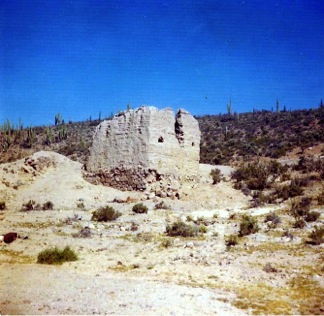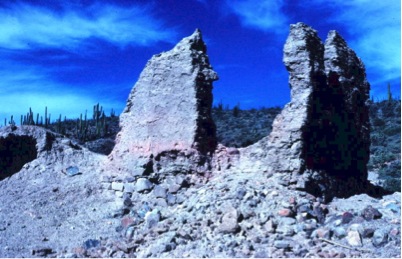
By David Kier
www.vivabaja.com
Co-author of ‘The Old Missions of Baja & Alta California, 1697-1834’
San Fernando was the first California mission founded by the Franciscan Order, and also the only Franciscan-founded mission on the California peninsula. Originally, California was believed by many to be an island. Once it was established California was a peninsula, Spain wanted to expand north to prevent the Russians or British from claiming the land. The peninsula was afterwards known as Antigua (Old) California, and the land from San Diego north was called Nueva (New) California. Later, the names changed to Baja (Lower) California, and the new area was called Alta (Upper) California. However, the two Californias did not become separate political districts until 1804.
For over seventy years the Society of Jesus (the Jesuits) operated the missions. They had negotiated for exclusive control over California, and over the Spanish soldiers stationed there. The Jesuits were granted this special authority, and agreed to not receive any Royal funds for their California project. They obtained private financing for the entire mission system, usually from wealthy Europeans. Previous attempts to establish missions in California failed, in part because of the hostile actions of the soldiers against the Indians. The Jesuits purpose in California was to learn the Indian languages, convert the natives to Christianity, teach them European methods of living, and to occupy the land for the King of Spain. They needed to have authority over the soldiers to prevent brutality against the Indians. Many years later rumors claimed the Jesuits were disrespecting the King’s authority, and amassing great wealth. The rumors spread about the Jesuits later proved to be false.
The next California mission site after Santa María was called Velicatá by the Cochimí natives and was discovered on March 5, 1766 by the Jesuit missionary Padre Wenceslao Linck while exploring for new mission locations. Velicatá was ideal with plenty of good water and friendly Indians to baptize. Before the Jesuits could establish a mission there, they were removed from all of the New World by orders of Spain’s King Charles III. The 16 Jesuits in California left in February of 1768 and were replaced by the Franciscans, who arrived two months later. The Franciscans were under the authority of the Spanish government and without the special conditions that the Jesuits had arranged. The Franciscans and the Dominicans who followed seemed less interested in native language skills. They also did not allow the Indians as much freedom to move about as had the Jesuits.
During his trek north from Loreto to establish missions in Alta California (at San Diego and Monterey), Junípero Serra founded his first mission, at Velicatá. This was on March 14, 1769, and Serra named it San Fernando. As Serra was to continue north to San Diego, he placed Padre Miguel de la Campa y Cos in charge of the new mission. Some 390 Indians were baptized by Padre Campa y Cos. Livestock and farming was productive thanks to the construction of a dam and canals. In February of 1772, Padres Antonio Linares and Vicente Fuster relieved Campo y Cos, at San Fernando.
A visita (satellite mission visiting station) of San Fernando was located 15 miles north, at San Juan de Dios. In 2008, a farmer clearing and plowing the desert destroyed the adobe ruins at San Juan de Dios. This happened despite it being a historic site documented by INAH (Mexico’s history and anthropology agency). San Juan de Dios is 22 dirt road miles northeast from Km. 103 on Highway 1.
Upon recognizing the potential of Alta California, the Franciscans relented to the Dominican’s requests to share mission duties in California. The Dominicans were to operate all the active missions founded by the Jesuits plus the one Franciscan mission founded at Velicatá (San Fernando). They were also to establish five new missions between San Fernando and San Diego. This was indeed far more than the Dominicans had bargained for and only later did they discover why the Franciscans so readily gave up the peninsula missions. After just five years, the Franciscans handed over Mission San Fernando and the other dozen active Baja California missions to the Dominicans. The Jesuit missions that had been closed before the Dominicans arrived were San Juan Bautista de Malibat, Santa Rosa, Los Dolores, and San Luis Gonzaga. Mission Santa María was closed soon after the Dominicans arrival.
In July, 1773, San Fernando was transferred to the Dominicans and had a church and a priest’s dwelling both made of adobe and covered with tules (Schoenoplectus acutu). The new Dominican priest assigned to San Fernando was Miguel Hidalgo and he was assisted by Padre Pedro Gandiaga. Gandiaga served San Fernando mission for the next seventeen years. There was friction between the Franciscans and Dominicans at San Fernando when the Franciscans insisted on taking the Baja California mission possessions with them to Alta California, including food needed to feed the neophytes at San Fernando.
Between 1774 and 1775, 500 natives were baptized by Padres Hidalgo and Gandiaga. In 1775, the mission of Santa María was closed and its neophytes transferred to San Fernando, jumping the newer mission’s population to 1,406. In the next seven years ending in 1782, the population of San Fernando mission was down to 642 as epidemics took their toll. The 1782 mission livestock report shows it had 110 head of cattle, 178 sheep, 65 goats, and 31 mules and horses. The mission farm produced 615 bushels of wheat, 685 bushels of corn and 178 bushels of barley. A small amount of cotton was also grown.
Many other Dominicans also served at San Fernando over the following years and include the names Galisteo (1773-1774), Garcia, Perez, and Bustamente (1775), Gines, June, and Perez (1778), Perez (1780-1782), Valero (1781), Luesma (1782-1783), Formoso (1785 & 1788), Azevedo (1788-1789), Marin and Abad (1789), and Sanchez (1790).
Padre Jorge Coello relieved Padre Gandiaga in mid-1790 and served the next five years at San Fernando. The adobe church building was about 85 feet by 16 feet, when reported in 1793. Another succession of visiting Dominican entered the record book under the names Apolinario (1795), Belda and Caulas (1797-1798), and Arviña (1799). In 1798, a new adobe building measuring 45 feet by 20 feet was erected for storage. Padre Antonio Lázaro served from March, 1799 to December, 1804 and in those five years only baptized 32 native Indians. The mortality rate from smallpox, measles, syphilis, and the ‘European style of living’ for the Cochimí natives far outpaced their birth rate.
Antonio Lázaro was replaced by Padre Mauel del Aguila (1804-1806). Padre Aguila had seen a neophyte population of 295 drop to 201 in his two years. By 1814 less than 100 native converts were counted. Entries into the record book were made by several other priests from 1808 to 1825. The exact date of abandonment is not clear but we can see from the book of records that the final marriage was on Oct. 3, 1814 by Padre Berardo Solá. The final baptism entry was on June 21, 1818 by Padre José Martín. The final death notice was entered into the mission book on Oct. 19, 1821 by Padre Francisco Troncoso. The last entry into San Fernando’s book of records was on May 16, 1825 for the visitation of Padres Domingo Luna and Félix Caballero.
The mission is reached about three miles west from Highway 1, at El Progreso café (Km. 121). El Progreso is about 39 miles from the Pemex gas station in El Rosario.
Photos show the erosion of the roofless adobe mission church over 86 years…
Visita de San Juan de Dios
David Kier is co-author of ‘The Old Missions of Baja & Alta California, 1697-1834’. The book is available for purchase HERE or at the DBTC offices (call 800-727-2252).














One thought on “The Spanish Missions on the California Peninsula: #18, San Fernando de Velicatá (1769-1825)”